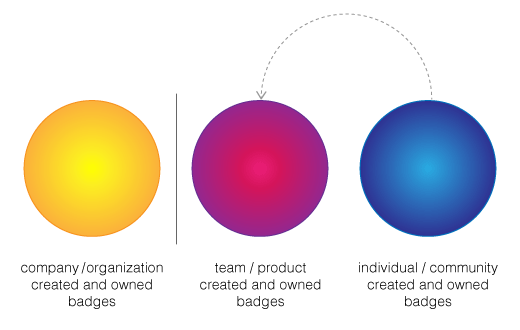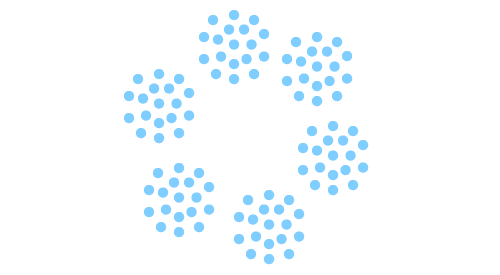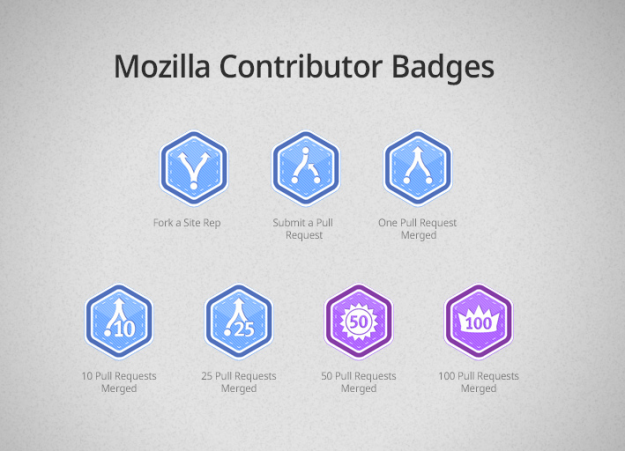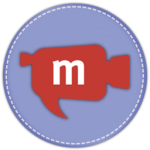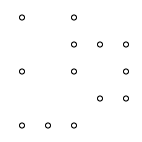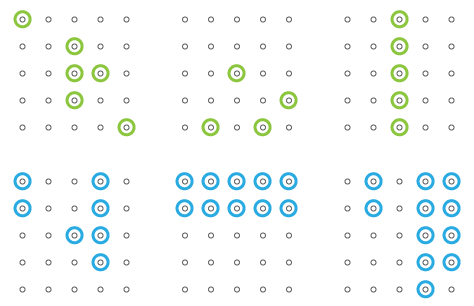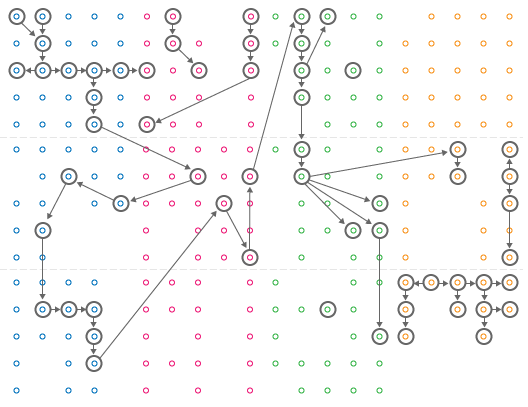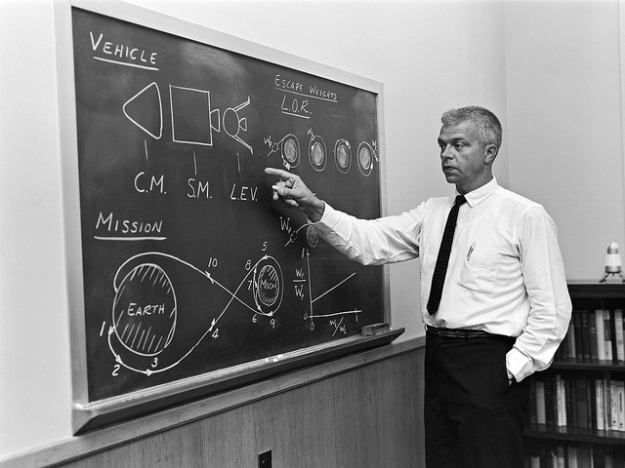The last two years or so have found me investigating and contemplating many different types of badge systems. Along the way I’ve been wrestling with considerations of badge types, potential taxonomies, and conceptual approaches; feeling my way around a variety of assessment types including summative, formative and transformative. Working in badge system design rewards a person with a continuing sense of adventure and opportunity.
A badge system structure for many
After much thought and many contemplative examinations, I’ve developed an archetypal badge system structure that I’m happy to recommend to the open badges community. Here are the many reasons why I think you’ll want to implement it.
- It’s simple.
- It’s modular.
- It’s easy to implement.
- It encourages a range of creativity.
- It works for organizations of vastly different sizes.
- It accomplishes the difficult task of working from bottom up, top-down, and middle out.
- It not only allows for growth, it thrives on it.
Introducing the 3 Part Badge System
This badge structure is the one that I developed for the Mozilla badge system that we are in the process of building. I’m calling it the 3 Part Badge System (3PBS).
It’s composed of three interlocking parts and those three parts create a flexible structure that ensures feedback loops and allows the system to grow and evolve. Or breathe. And by breathe, I mean it allows the system to flex and bow as badges are added to it. While some community member organizations have expressed a desire for a strict, locked-down, top-down badge system to—in their words—guarantee rigor (and you already know my thoughts on this), this system supports that request but is also designed to include active participation and badge creation from the bottom up. I’d say it’s the best of both worlds but then I’d be leaving out the middle-out capacity of this system. So in reality, it’s the best of all possible worlds. This approach is a vote for interculturalism—or the intermingling and appreciation of cultures—in badge systems. Its strength arises from the continuous periodic review of all of the badges, in particular the team / product badges as well as the individual / community badges.
Don’t tell me, show me
It’s easier to talk about this system with some visuals so I’ve designed some to help explain it. Here is the basic 3 part structure: Part 1) company / organization badges; Part 2) team / product badges; and Part 3) individual / community badges. This approach avoids a monocultural hegemony.
Part 1: Company / organization badges
Many companies and organizations have specific needs and concerns about branding. This system addresses those concerns directly. In this proposed system, an advisory group defines, creates, and governs the highest level of badges—the company / organization badges—providing control over the all-important corporate or academic brand. While not all systems have a need for such strict brand maintenance requirements, this approach allows for conceptual levels of badges to be created while interacting in organic and meaningful ways with other types of badges. An advisory group creates and vets these badges based on the organization’s foundational principles and values. The company/organization badges transmit the most important values of an institution and they address organizational concerns regarding brand value and perceived rigor.
Part 2: Team / product badges
Few organizations exist that do not have some middle layer accomplishing the bulk of the work of the organization; the 3PBS proposal recognizes the team / product groups as necessary and important partners. In addition to acknowledging the contributions of this collection of folks, 3PBS engenders them with the ability to respond to their public through badges. Different teams and products groups can clearly and unequivocally communicate their closely held qualities and values through the creation and issuance of their own badges. These badges are created entirely independently of the Part 1 company / organization badges. In a bit we’ll discuss how the team / product badges play a role in influencing other aspects of the 3PBS.
Part 3: Individual / community badges
So your organization is comprised only of management and teams? Of course not. The 3PBS honors the folks who are on the front lines of any organization—the community—by empowering them to define their values internally as well as externally. These badges operate outside the requirements that define the Company/organization badges and the Team/product badges. The community badges can be created by anyone within the community and do not hew to the visual requirements of the other two subsystems. What this means is that an individual or community can create any types of badges they like. In other words, it provides the ability to publicly participate—to have a voice—in the system.
How the three different parts influence one another in the 3 Part Badge System
How do these parts interact? In order to communicate how these subsystems can affect each other, I’ve created some color based graphics. You’ve already seen the first one above that describes the initial system. But first a little basic color theory to ground our understanding of how these subsystems work together to create a dynamic and powerful system. The basic 3 part structure graphic above uses what are known as primary colors, from the Red, Yellow, Blue color model. Centuries of art are based on these three colors in this color model. (Learn even more about color theory here.)
The following graphics further explore the RYB color model and move us into the world of secondary colors. Secondary colors result from the mixing of two primary colors: mixing red and yellow results in orange; mixing yellow and blue results in green; mixing blue and red results in purple. Now that we’ve established how the color theory used here works, we can see how the parts represented by these colors indicate intermixing and integration of badges.
Individual / community badges influence team / product badges
The 3PBS concept relies on badge development occurring at the individual and community level. By permitting and even encouraging community and individual level badging, the system can will continuously reform itself, adjusting badges upward in importance in the system. That’s not to say that any part of this system is superior to another, merely that these parts operate in different ways to different audiences. As I wrote in my last post, meaning is highly subjective and context-specific.
This graphic illustrates the team / product created and owned badges assimilating some badges from the individual / community created and owned badges. The graphic also indicates that the company / organization badges can be held separate from this influence—if so desired. Periodic review by the team / product groups of the individual and community badges likely will reveal patterns of use and creation. These patterns are important data points worth examining closely. Through them the larger community reveals its values and aspirations. Consequently, a team or product group may choose to integrate certain individual / community badges into their own badge offerings. In this way a badge begins to operate as a recognized form of social currency, albeit a more specific or formalized currency. The result of this influencing nature? The team and product group badge subsystem refreshes itself by assimilating new areas of interest pulled directly from the larger, more comprehensive and possibly external community.
Team / product badges badges influence company / organization badges
Company and organization level badges operate in precisely the same way, although the advisory group who is responsible for this level of badge can look across both the team / product badges as well as the individual / community badges. That experience will look something like this in practice.
Periodic review of the team / product badges by the advisory group responsible for company and organization badges may reveal duplicates as well as patterns. Discussion between the advisory group and the teams responsible for those badges may indicate that a single standard badge is appropriate. Considering that teams and product group badges are created independently by those groups, apparent duplication among teams may not necessarily be a bad thing: context is all important in the development and earning of badges. That said, examination and hybridization of some badges from the team and product groups may create a stronger, more coherent set of company and organization level badges.
Individual / community badges influence company / organization badges
In addition to being able to examine and consider team and product level badges, the advisory group responsible for the company / organization badges can also find direct inspiration from individual and community created badges. Since there are few to no rules that govern the creation of the individual / community created and owned badges, insightful, dramatic, and wildly creative badges can occur at this level. Because they come through entirely unfiltered, those sorts of badges are precisely the type to encourage rethinking of the entirety of the 3PBS.
Here we see how the individual / community created and owned badges can significantly color the company / organization badges. Since the company / organization badges communicate universal values, it’s vital that those values remain valid and meaningful. Incorporating fresh thinking arising from individual and community badges can help to ensure that remains true.
Three parts, one whole
So, if we loop back to the original system, prior to the (color) interactions of one part to another, we can see how each part might ultimately influence one another. This is the big picture to share with interested parties who are curious as to how this might work.
So, that’s the 3 Part Badge System in a nutshell. Looking forward to hearing your thoughts.
—-
Much more soon. carla [at] badgealliance [dot] org

